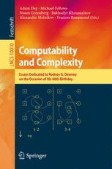Search
Search Results
-
Quantum Logical Depth and Shallowness of Streaming Data by One-Way Quantum Finite-State Transducers (Preliminary Report)
The logical depth of a piece of data has served as a complexity measure to describe the amount of “usefulness” and “non-randomness” of information...
-
Boosting Pushdown and Queue Machines by Preprocessing
Motivated by preprocessing devices occurring for example in the context of syntactic parsers or HTML sanitization, we study pairs of finite state...
-
Transducing Reversibly with Finite State Machines
Finite state machines are investigated towards their ability to reversibly compute transductions, that is, to transform inputs into outputs in a...
-
Injection Structures Specified by Finite State Transducers
An injection structure \({\mathcal A}= (A,f)\)...
-
Reversible Pushdown Transducers
Deterministic pushdown transducers are studied with respect to their ability to compute reversible transductions, that is, to transform inputs into...
-
TeSSLa: Temporal Stream-Based Specification Language
Runtime verification is concerned with monitoring program traces. In particular, stream runtime verification (SRV) takes the program trace as input...
-
Notes on spiking neural P systems and finite automata
Spiking neural P systems (in short, SN P systems) are membrane computing models inspired by the pulse coding of information in biological neurons. SN...

-
Simple linear string constraints
Modern web applications often suffer from command injection attacks. Even when equipped with sanitization code, many systems can be penetrated due to...
-
Postselection Finite Quantum Automata
Postselection for quantum computing devices was introduced by S.Aaronson[2] as an excitingly efficient tool to solve long standing problems of...
-
Size of Quantum Finite State Transducers
Sizes of quantum and deterministic finite state transducers are compared in the case when both quantum and deterministic finite state transducers...
-
A Flexible Rule Compiler for Speech Synthesis
We present a flexible rule compiler developed for a text-to-speech (TTS) system. The compiler converts a set of rules into a finite-state transducer...
-
Quantum Finite State Transducers
We introduce quantum finite state transducers (qfst), and study the class of relations which they compute. It turns out that they share many features...
-

